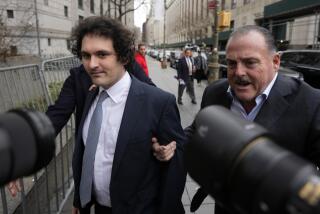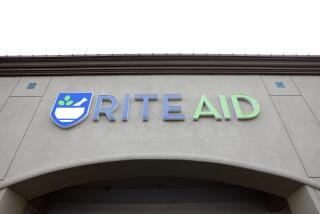Bush Signs Thrift Bailout; Crash Rescue Program Set
WASHINGTON — President Bush, signing into law a massive savings-and-loan rescue package, Wednesday set in motion a seven-week crash program to put the sickest thrifts out of their misery and to clear the way for a reshuffling of the nation’s lending institutions.
The bailout, the biggest ever undertaken by the federal government, authorizes $20 billion over the next seven weeks and another $30 billion in the following two years to close hundreds of S&Ls; and make good on federal insurance of deposits up to $100,000.
The total cost, including interest payments on the bonds that will be sold to raise the up-front cash, will reach an estimated $148 billion over the first 10 years of the rescue effort, according to revised government projections.
Taxpayers will pay about $47 billion of the 10-year cost--about $300 per taxpayer--and the financial industry will pick up the rest, mainly through higher deposit insurance fees. But after 10 years, taxpayers will be responsible for meeting virtually all of the cost of the debt service.
At least one-third of the roughly 3,000 S&Ls; operating today are expected to disappear within the next few years, and many of the remaining thrifts are likely to be absorbed into large banking institutions.
The bailout, enacted six months after Bush called on Congress to pay for a decade of neglect and mismanagement of the thrift industry, will protect depositors against losses on their savings accounts while attempting to prevent ailing S&Ls; from ever again threatening the health of the U.S. financial system.
The S&L; cleanup will “safeguard and stabilize America’s financial system,” Bush said at a White House Rose Garden ceremony. “While the S&L; crisis isn’t behind us, we have met and passed our first critical test.”
The bill authorizes $20 billion in emergency spending before the current fiscal year ends on Sept. 30 and another $30 billion over the next two fiscal years to close ailing institutions and reimburse depositors. Those sums are in addition to $32 billion already used in previous government actions to dispose of failed S&Ls.;
But critics believe that the immense rescue package still will fall short of completing the task of shutting down more than 1,000 thrifts expected to go out of business over the next few years.
‘Never Be the Same’
“The S&L; industry will never be the same again,” said Robert Litan, a financial industry specialist at the Brookings Institution. “Thrifts are going to be a very attractive target for banks, which will only accelerate the end of the distinction between banks and thrifts.”
The huge shakeout of financial institutions should have little impact on home buyers, who still will have plenty of places to go for mortgage financing.
Savers also are likely to see interest rates come down slightly at many thrifts as healthier S&Ls; no longer have to compete with the artificially high rates offered by sick institutions that have managed to stay alive only through infusions of expensive funds.
Those above-market rates should come to an end over the next few months as ailing S&Ls;, as they are taken over by the government’s new Resolution Trust Corp., replace their costly deposits with less-expensive money raised by bonds sold by or guaranteed by the U.S. Treasury.
The new legislation, known as the Financial Institutions Reform, Recovery and Enforcement Act of 1989, demands that thrifts move quickly to set aside a minimum of 1.5% of their assets as capital as a cushion against future losses.
Thrifts, which were allowed to follow looser accounting standards for years because of their favored role in financing home mortgages, will be expected to meet essentially the same capital standards as banks--capital reserves equal to 3% of assets--by the end of 1994.
Ends Cozy Relationship
The law also imposes tough new rules on the once-coddled thrift industry, dismantling the cozy regulation of S&Ls; by the Federal Home Loan Bank Board and replacing the board with a new office in the Treasury Department. The legislation also turns over to banking regulators the responsibility for insuring the safety of savings deposits.
Under the overhaul, federal deposit insurance for S&Ls; will be provided by a new insurance fund called the Savings Assn. Insurance Funds.
“I’m proud to sign this monster,” Bush told roughly 300 people participating in the ceremony approving the 1,000-page, nearly foot-thick bill.
Almost immediately after Bush signed the bill, Treasury Secretary Nicholas F. Brady convened a meeting of the new Resolution Trust Corp. oversight board, set up to supervise sales of sour loans and repossessed real estate that the government is inheriting from failed thrifts.
“We’ve got a good solution to a very difficult problem,” Brady told reporters after the meeting. “This is a package that will return S&Ls; to a sound path.”
The board voted to spend $815 million as the first installment toward shutting down or merging those S&Ls; with the worst balance sheets. About $250 million will be used to take over three unnamed institutions expected to be identified today.
The meeting of the oversight board was quickly followed by the opening session of the Resolution Trust Corp. itself, which will be under the direction of L. William Seidman, chairman of the Federal Deposit Insurance Corp. The FDIC will assume the role of insuring savings deposits in addition to its bank supervision functions.
The new agency’s mission will be to “restructure insolvent S&Ls; and return their assets to the private sector using funds received from the federal government,” Seidman said.
The RTC began its massive task by assuming control of 262 S&Ls; in 33 states with assets of $104 billion. The institutions were seized by the FDIC this year and will now be run by the RTC until they are closed or sold.
Among the S&Ls; now run by RTC are 22 in California with assets of $21.3 billion. Another $100 billion to $300 billion in assets will be acquired, depending on how many individual institutions are “turned over to the RTC for restructuring,” Seidman said at a news briefing after the close of the formal meeting. The corporation’s meeting was devoted to adopting bylaws, announcing personnel actions and other technical details.
In disposing of the huge holdings it will acquire from failed thrifts, the RTC will be faced with the challenge of balancing the advantages of quick sales against the potential gains of hanging on to properties until values improve.
“A lot of different strategies will be pursued in different markets,” a White House official involved in the legislation said. “The approach in Los Angeles is likely to be quite different from that in West Texas.”
THE GOVERNMENT’S S&L; RESCUE PLAN Major features of the bill to bail out the savings and loan industry: Provides $50 billion from bond sales to shut down or merge hundreds of bankrupt S&Ls; and make good on federal deposit insurance.
Authorizes the spending of about $300 billion over the next 30 years to pay off the bonds and meet other costs.
Requires taxpayers to foot about two-thirds of that bill and banks and healthy S&Ls; to pick up the other third.
Requires S&Ls; to maintain at least 3% of their assets as capital that would be available to pay depositors.
Prohibits S&Ls; from investing in high-risk, high-yield “junk bonds.”
Establishes the Resolution Trust Corp., managed by the Federal Deposit Insurance Corp., to shut down or merge the hundreds of sick S&Ls; and to manage and sell their billions of dollars in assets.
Abolishes the Federal Home Loan Bank Board and creates a new Treasury Department agency called the Office of Thrift Supervision to oversee the S&L; industry.
Abolishes the Federal Savings & Loan Insurance Corp. and transfers responsibility for insuring S&L; deposits to the new Savings Assn. Insurance Fund, to be supervised by the FDIC.
More to Read
Sign up for Essential California
The most important California stories and recommendations in your inbox every morning.
You may occasionally receive promotional content from the Los Angeles Times.










